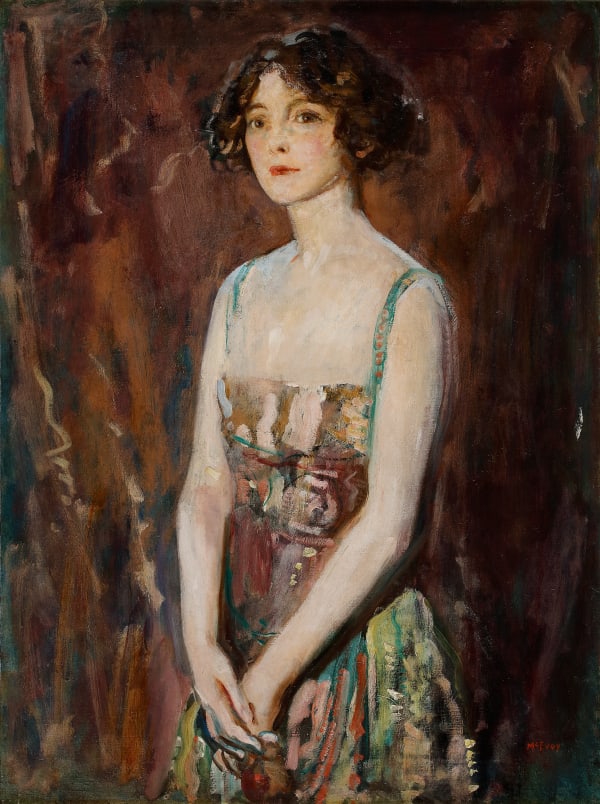
Ambrose McEvoy
To view all current artworks for sale visit philipmould.com
When this work was exhibited at the New English Art Club just after Ambrose McEvoy’s shocking and sudden death of pneumonia at the age of only forty-nine, the Times critic praised the painting – which had been given pride of place in the exhibition – for serving ‘very well to recall the characteristic powers of the artist’. Going on, he wrote perceptively that it is ‘essentially a study of a transitory effect of light, colour, and movement—it might almost be called “She Passes”.[1]
These were the qualities that McEvoy had sought to evoke in his art for the whole of his career. Painted in 1917, the work sees the artist at the height of his powers and with his star firmly in the ascendant. An American, he was the son of a distinguished soldier in the American Civil War. Following early encouragement by James Abbott McNeill Whistler (1834-1903) – the greatest American artist of his day and a friend of the family – McEvoy went to study at the Slade School of Fine Art in London. When there, his classmates included the brilliant brother and sister duo, Augustus (1878-1961) and Gwen John (1876-1939). McEvoy quickly struck up a friendship with the pair and became the lover of Gwen; he left her heartbroken, however, following his sudden decision to marry another Slade pupil, Mary Edwards (1870-1941), to whom he remained married for the rest of his life.
Following the 1915 exhibition of the portrait that he painted of Mary, McEvoy became highly in demand as a society portraitist. Word of his talents soon spread to New York and he was invited to the city at the insistence of the plutocrats of the Gilded Age. Greatly feted on his arrival, he was honoured with an exhibition at the galleries of Joseph Duveen (1869-1939), the most successful art dealer of his day, where the present work was shown as one of the best instances of this exciting young talent.
McEvoy made a special line in his portraits of glamorous and beautiful society women. One such was Lady Gwendoline (sometimes spelled “Gwendeline”) Churchill, the wife of stockbroker Jack Churchill (1880-1947) and, thus, sister-in-law of his brother, Winston Churchill (1874-1965). The Churchill family and their cousins, the Malboroughs, had been frequent patrons of McEvoy, with the artist also painting likenesses of Consuelo, Duchess of Malborough (1877-1964) and of Winston Churchill. He painted Gwendoline on at least two other occasions. The first of these, a watercolour sketch, is preparatory for the present work, illustrating the careful and meticulous preparation that lies behind this image of fleeting nonchalance.
Gwendoline was a close friend and confidante of her brother-in-law and future hero of the Second World War, Winston. Their two families frequently holidayed together, and each year spent Christmas and Easter together at Blenheim.[2] Indeed, it was Gwendoline who introduced Winston to painting as a means of keeping his ‘black dogs’ at bay following his resignation from the Admiralty in the wake of the disastrous 1915 Gallipoli Landings. In testament to their emotional bond, Winston painted Gwendoline’s portrait, one of the very few that he ever made.
Though not formally educated herself, Gwendoline was a witty and vivacious host to artistic and literary figures, whose company she adored. From patron of the arts Lady Ottoline Morrell (1873-1938), to authors such as J.M. Barrie (1860-1937), and painters of the likes of Sir John Lavery (1856-1941) and William Orpen (1878-1931), her friendships placed her at the heart of the cultural society of her day. Unlike many of her aristocratic peers, she had married Jack Churchill for love (her father had been difficult to persuade). During the First World War – when this work was painted – Gwendoline had turned her efforts to nursing, dedicating herself to All Saints’ Hospital. She fretted, however, for her husband, a valiant and decorated wartime commander. To calm her nerves, she became a habitual smoker. This was, sadly, to kill her. In 1941, following a three year long battle with the disease, she died of lung cancer. The event deeply distressed aristocratic society, which was then bracing itself for the mounting trauma of the Second World War. Popular and endearing to all who met her, many felt the need to write to the newspapers, which were inundated with an almost unheard-of number of letters of remembrance. Of all the tributes, perhaps none can sum up her character better than a letter to The Times by a friend who wrote, ‘one word describes Lady Gwendoline Churchill – the dear old word, seldom used now, “enchanting”.[3] It is this quality, above any, that McEvoy captures in this portrait.
[1] “The New English”, The Times (London), 8th March 1927, p. 14.
[2] Celia Lee and John Lee, The Churchills: A Family Portrait (New York City, 2010), p. 162.
[3] “A Friend Writes”, The Times (London), 22nd July 1941.
Provenance
The artist’s estate.
Exhibitions
Grosvenor Gallery. (1917). National Portrait Society April-May.
Duveen Brothers, New York City. (1920), The Ambrose McEvoy Exhibition, no. 16, illustrated;
Probably, The New English Art Club, Spring Gardens Gallery. (1927) Seventy-Fifth Exhibition, 9th-30th March.
Literature
The Work of Ambrose McEvoy (London, 1923), no. 5, illustrated p. 43.
- X
- Tumblr
This website uses cookies
This site uses cookies to help make it more useful to you. Please contact us to find out more about our Cookie Policy.
Be the first to hear about our available artworks
* denotes required fields
We will process the personal data you have supplied in accordance with our privacy policy (available on request). You can unsubscribe or change your preferences at any time by clicking the link in our emails.
